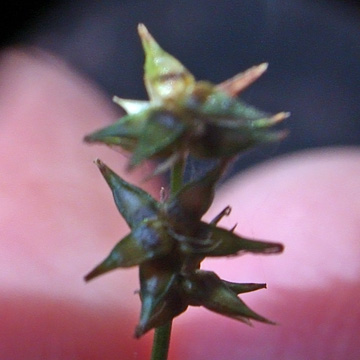

Carex texensis - (image 1 of 3)
Taxonomy
Family: Cyperaceae
Section Phaestoglochin
Synonymous with C. retroflexa var. texensis
Habitat
Dry to mesic open woods and fields, often in rocky or sandy soil.
Associates
Distribution
Northwest IN to southeast MO, south to SC, MS, and TX.
Morphology
Tufted perennial; stems 20-40 cm; leaves elongate, flat, 1-1.7 mm wide; spikes 3-8, ovoid or subglobose, 5-8 mm, androgynous, the lower separate and subtended by setaceous bracts 1-5 cm, the upper approximate with much shorter or no bracts; pistillate scales ovate, acute to short-acuminate or cuspidate, nearly as long as the perigynia and usually deciduous before maturity; perigynia green to brownish-green, spongy thickened and nerveless or nearly so at the base, 2.6-3.4 mm long and 1-1.3 mm wide, the beak smooth-margined, sharply but shortly bidentate; achenes ovate, 1.3-1.5 mm long.
Notes
Fruiting April to early June
Wetland indicator: NA
Very much like C. retroflexa but with the spongy base of the perigynium nerveless or nearly so and the perigynium 1/3 as wide as long (vs. C. retroflexa with the spongy base distinctly nerved and the perigynium 2/3 to 1/2 as wide as long). It has been introduced to CA, NJ, NY, and OH. These plants were found in a lawn in Central NY, probably introduced with a lawn seed mix.
References
Ball, P.W. and A.A. Reznicek. 2002. Carex, In: Flora of North America Editorial Committee, Eds. Flora of North America North of Mexico. Volume 23. Oxford University Press, New York.
Gleason, Henry A. and A. Cronquist. 1991. Manual of Vascular Plants of
Northeastern United States and Adjacent Canada. Second Ed.
The New York Botanical Garden. Bronx, NY
|
© Michael Hough 2018 |